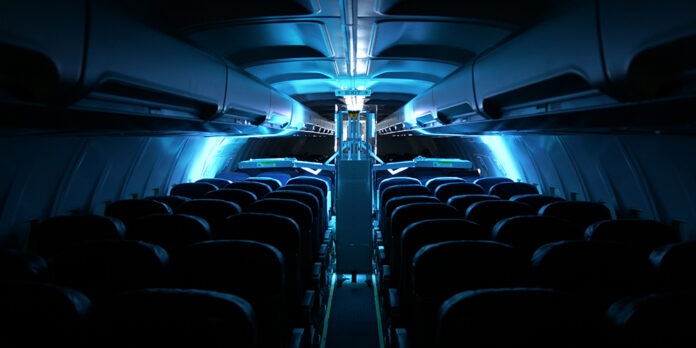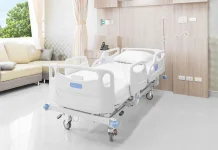
by Liz Stevens, writer, UV Solutions
UV-C increasingly is used for disinfection of indoor spaces, especially in light of the persistent COVID-19 coronavirus and its variants. Los Angeles, California-based Dimer LLC has been pioneering UV-C innovations since 2012 when orthopedic surgeon Dr. Arthur Kreitenberg, the company’s co-founder, leveraged his experience with operating room UV disinfection to develop a UV disinfection technology for use in the sports sector.
Kreitenberg and Dimer next turned to developing UV-C disinfection technology for airplanes – a transportation method rife with opportunities to spread germs and viruses worldwide. The company’s GermFalcon is a beverage cart-sized mobile system that airlines use to disinfect their aircraft between flights. GermFalcon was named a TIME invention of 2020 in the transportation category, and Dimer now is in partnership with Honeywell to deploy the technology on a global basis.
Building upon the technology of GermFalcon, Dimer has designed and manufactures a mobile UV-C disinfection system for use in ground-based indoor spaces. The UVHammer is an operator-driven unit that can be wheeled around a space for disinfection of surfaces, capable of disinfecting more than 12,000 sq. ft. per hour. The battery-operated system includes a shield that protects the operator from UV-C exposure and features other safety measures to further protect the operator.
Daniel Carr, vice president of accounts and customer success at Dimer, described the system’s UV-C lamps and their efficacy. “The UVHammer uses low-pressure mercury fluorescent 254 nm lamps,” said Carr. “These have the highest ‘Dimer ratio,’ defined as ‘germkill / watt,’ based on microbiology and energy measurements.” The entire device delivers 475 W of power. Dimer describes UVHammer as capable of killing 99.99+% of pathogens on all high-touch surfaces – in any environment. “COVID-19 testing has been completed using the lamps,” Carr further explained. “They can achieve surface dosing greater than 22 mJ/cm2, which is sufficient for a 6 log reduction of SARS-CoV-2 in less than four seconds (not minutes). Airborne virions (virus outside of a host) in the airspace exposed to UV-C also are deactivated as the UVHammer traverses the room.”
UVHammer’s UV-C lamps are set in a nearly 300 W UV-C Wing to allow for adjustable exposure of surfaces, and additional UV-C lamps are trained on the device’s wheels to prevent any cross-contamination as the machine is moved from room to room. “During use,” said Carr, “the operator guides the UVHammer and adjusts its wing as necessary to thoroughly and rapidly expose any and all surfaces from a few inches away, in any environment of any size.” Reduced distance, elimination of shadows and optimized angles of incidence ensure optimal disinfection, which Carr described as being applicable in spaces ranging from bathroom stalls to convention halls.
The operator receives real time dosage data. “A critical part of the UVHammer operator training is understanding the relationship of distance-to-target and travel speed,” explained Carr. “The machine provides real-time data to assist and enhance the operator’s ability to complete effective treatment in a space. Dimer also provides its proprietary Dimer Dots to each facility using a UVHammer.” Dimer Dots are small photochromic stickers that provide real-time visual feedback and indicate the UV-C dose delivered to a specific surface.
Of particular interest is the UVHammer’s UV-C Wing (also used in Dimer-Honeywell UV aircraft disinfection devices). “Wing adjustments are fully operable while the lights are engaged and UVHammer is in action,” said Carr. “The operator can manipulate wing positions on-the-go for maximum disinfection efficiency. The Wing can be lowered to within inches of the floor and raised high enough to reach a top shelf.” The Wing also is fully adjustable from a horizontal to a vertical position, allowing the operator to aim the UV-C light in the most effective angle for disinfection. Dimer earned a IUVA 2021 RadLaunch Award for the UV-C Wing.
Dimer’s UVHammer initially was designed by Dr. Kreitenberg for use in surgical suites. While the company’s sales focus remains centered on healthcare applications, Dimer also has customers in professional sports, fitness, education and manufacturing. “We always are innovating,” said Carr. “Dimer’s ethos provides college students and promising high school STEM students with research internship opportunities. These talented young people bring ‘fresh eyes’ that help us see new methods and applications for future development.” Maya Jaffe, a Dimer intern and bioengineering undergrad at Georgia Tech, wrote “UV-C Effectiveness and the ‘Canyon Wall Effect’ of Textured Healthcare Environment Surfaces,” which appeared in the Q4 2019 issue of UV Solutions. She will start medical school in 2023.
Dimer currently is scaling up manufacture of the UVHammer product line and also is working with Honeywell to expand deployment of the latest version of its aircraft disinfection technology. For more information, visit www.dimeruv.com.





